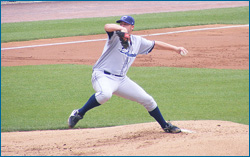
The next time you are in the kitchen, try this experiment: pick up a box of butter (four sticks) in one hand and a box of saltines (four packets) in the other. Which is heavier? If you said the butter, you are not alone. Most people would identify the box of butter as the heavier object — even though, if you look at the labels, you’ll see that they both weigh exactly one pound! This is an example of the size-weight illusion, and it is incredibly common. Most people — very young children, people from different cultures, and even people who know ahead of time that the two object weigh the same — report that the smaller of two objects of equal mass just “feels” heavier. Why is this? Recent research suggests that the roots of this modern party trick (as well as our penchant for sports like baseball and football) can be traced back to the evolutionary origins of Homo sapiens and to the opportunities provided by a well thrown rock or spear.
Where's the evolution?
When we humans make judgments, we often feel that we are 100% in charge of our thinking — that we simply observe the world as it is and make a conscious decision about it — but in fact, our brains and sensory systems have built-in biases that may subtly (or not so subtly!) influence both our perceptions and decision-making. Psychologists have demonstrated lots of them: We pay more attention to observations that support our current ideas than to observations that contradict what we already think. If an object is moving to the right, we perceive it as being further to the right than it actually is. We think that sounds that get louder are changing more than sounds that get softer. We view travel routes with more turns as longer than straight routes, even when they are the same distance. And those are just a few of the biases that shape how we view the world.
Biases that are hard-wired — those that are not learned through experience with the world — have evolutionary explanations. Some are simply by-products of the evolution of another feature. For example, the bias in our perception of travel distance may be a side effect of how our brains have evolved to efficiently estimate the passage of time. Other biases are adaptations themselves. For example, as the source of a sound gets closer to us, the sound becomes louder. Perhaps our bias for overestimating the change in an intensifying sound is something of an early-alert warning system, sensitizing us to potential danger approaching, and was favored by natural selection. Those with this perceptual bias may have been more likely to escape attacks and survive to reproduce than those without the bias (though further studies would be necessary to determine if this bias is actually an adaptation).
Scientists have long noted the universality of the size-weight illusion and formulated different hypotheses to explain it: is it just an inconsequential side effect of how our brains estimate mass, or is there some hidden value to persistently underestimating the weight of large objects? Now new research suggests that this error may actually be an adaptation with roots in an important but sometimes overlooked aspect of human evolution: throwing skill. Picking up a ball and giving it a toss may be child’s play, but in fact, it relies on a complex set of skills and knowledge, as well as musculature and bone structure, that other primates don’t have. Chimpanzees, it turns out, have a bad arm and lousy aim. And while throwing skill may not seem that useful today (unless you’re a major league baseball pitcher, of course), to human ancestors living half a million years ago, it may have been invaluable. Throwing rocks and spears would have allowed ancient humans to bring down prey from a distance and take advantage of the element of surprise. Improved throwing ability could have given some early humans a big selective advantage over others in terms of their ability to get food.
How might the size-weight illusion aid throwing skill? When selecting an object to throw a long distance, size and weight are key. It is harder to throw a large, light object a long distance than it is to throw a smaller object of the same weight. (Just imagine throwing a beach ball and a ball bearing of equivalent weights. You’d be able to throw the ball bearing much further than the beach ball.) So, the larger the object, the heavier it must be in order to be thrown a long distance; however, the heavier the object, the more work is required to throw it a long distance. Balancing these two issues to select the ideal object for throwing is no simple task.
Scientists from the University of Wyoming and Indiana University decided to test whether the size-weight illusion might help people make judgments about the best objects for throwing. They had people judge the throwability of a set of objects of different sizes and weights and also asked them to judge which objects were of equivalent weights. Last month, they announced their results: objects judged to be equivalently throwable were also judged to be of equivalent weights! This suggests that our perception of an object’s mass in comparison to other objects could serve as stand-in for its throwability. In other words, if the researchers are right, when you are holding a box of butter and a box of saltines in your hands and perceive the butter to be heavier, you are really getting a grip on the throwability of those objects. They weigh the same amount, but your brain is unconsciously tuning into the fact that the butter would be a better object to throw.
Of course, you won’t be throwing cans of soup or boxes of butter at a passing wildebeest anytime soon. Human lifestyles have changed substantially since our basic anatomy and physiology evolved, but our bodies and brains still bear the marks of our deep evolutionary history. So the next time you find yourself impressed with a 60 yard pass for a touchdown or pick up a rock to skip across a lake, take a moment to reflect on the hundreds of thousands of years of evolution that have shaped what it means to act, feel, think, and throw like a human.
Primary literature:
- Zhu, Q., and Bingham, G. P. (2010). Human readiness to throw: The size-weight illusion is not an illusion when picking the best objects to throw. Evolution and Human Behavior. doi:10.1016/j.evolhumbehav.2010.11.005. Read it »
News articles:
- A popular article on the new research from Wired
- A press release on the study from EurekaAlert
- An article and radio program on the importance of throwing in human evolutionary history from NPR
Understanding Evolution resources:
- Review the concept of adaptation. In your own words, describe what an adaptation is and why scientists think that the trait described in the article above may have first evolved as an adaptation for throwing.
- Review the process of natural selection. Use the four steps described on that page to explain how a bias in our perception of the weights of differently sized objects may have evolved. Keep in mind that behaviors can have a genetic basis.
- Research another example of a human behavior that might have evolved as an adaptation and explain why it may have been adaptive.
- Read this article about the evolution of another important human trait, our ability to run. That article describes one way in which the modern world is a mismatch for the environment in which our human ancestors evolved and how traits that evolved in that context can actually cause problems for humans today. Do you think that the size-weight illusion (and the behaviors and skills stemming from that bias) represents a similar mismatch? Explain your reasoning.
- Advanced: Read more about adaptations to learn about four different lines of evidence that can be used to help determine whether a trait represents an adaptation or not.
- Which of these lines of evidence was addressed in the study described above? Explain your reasoning.
- Describe two additional lines of evidence that could be used to help explore whether the size-weight illusion originally evolved as an adaptation. For each line of evidence, explain how these data could be obtained and what outcome would support the idea that this trait originally evolved as an adaptation.
- Do you think that the size-weight illusion represents an adaptation in modern humans? Explain your reasoning.
- Teach about the evolution of human traits: This article for grades 9-12 describes how the ability to digest milk is a recent evolutionary innovation that has spread through some human populations.
- Teach about natural selection: This board game for grades 9-12 simulates natural selection. It is suitable for an introductory biology class and for more advanced classes where you could go into more detail on important principles such as the role of variation and mutation.
- Isaac, B. (1987). Throwing and human evolution. The African Archaeological Review. 5: 3-17.
- Jansen-Osmann, P., and Wiedenbauer, G. (2006). Distance cognition in virtual environmental space: Further investigations to clarify the route-angularity effect. Psychological Research. 70: 43-51.
- Joyce, C. (August 2, 2010). Armed and deadly: Shoulder, weapons key to hunt. The Human Edge. Retrieved February 1, 2011 from NPR.
- Neuhoff, J. G. (1998). Perceptual bias for rising tones. Nature. 395: 123-124.
- Whitney, D., Wurnitsch, N., Hontiveros, B., and Louie, E. (2008). Perceptual mislocalization of bouncing balls by professional tennis referees. Current Biology. 18: R947-R949.
- Zhu, Q., and Bingham, G. P. (2010). Human readiness to throw: The size-weight illusion is not an illusion when picking the best objects to throw. Evolution and Human Behavior. doi:10.1016/j.evolhumbehav.2010.11.005
